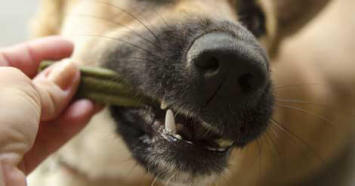
Want to know how to get your veterinarian to smile? Tell her you’re brushing your pet’s teeth. Almost nothing gives us such pleasure as a pet person so compliant and committed that they’re willing to do the one thing it seems most pet owners are loath to: dental care. This can also help prevent dental accidents and illnesses that would be covered by pet dental insurance. Only weight loss (the prescribed and worked-for kind) bests brushing for the wonderful things it says about your personal dedication to keeping your pet healthy.
Not to beat a dead tooth root here, but here’s where it bears reiterating the toothiest take-home point of my last diatribe on what not to do, dental-wise: Time and again, it’s been made clear by dentists and veterinarians the world around: it’s all about the brushing. Daily. For at least a minute. (Ideally.)
Which, by now, you already know. Rant over.
But what if you really, absolutely, categorically cannot brush your pet’s teeth in the manner prescribed? It’s true that plenty of pets will balk at any attempt to handle their mouths. I see this mostly with rescued adults who suffer anxiety or with those who harbor aggressive tendencies against their own humans. But these are decidedly in the minority.
It’s true; most pets can be trained to accept brushing. While it’s hard to get all but the most docile or well-trained to sit for the kind of brushing your dentist demands you do for yourself, it’s not so tough to get almost any pet to tolerate some kind of brushing. Consider the following case study:
For the Yorkie who has everything but the willingness to have you touch her mouth (and the cruddy mouth to prove it), her people absolutely need to start petting her around her face and mouth, gradually acclimating her to their presence there.
Over time, with patience, most pets can be brought to accept a dry, baby-sized finger brush in their mouths for a few seconds on each side every day. If this is all that ever happens, so be it. It’s way better than nothing. At the very least it stimulates their gums and loosens some of the tartar.
Sure, this means that most pets will interact only minimally with a toothbrush compared to what we demand our kids do, for example, but even the tiniest interaction with brushing might lead to more. What’s more, veterinary dentists are unanimous in this: Almost any brushing is better than almost anything else you might choose to do for your pets’ teeth.
Which brings me to the question whose answer will comprise the second half of this post: Beyond brushing, is there anything else that I can do that will make my pets’ teeth as healthy as possible?
#1 Professional Cleaning (anesthetically)
Veterinary dentists have shown that 80% of pets will have visible signs of periodontal disease after the age of three. Which means that nearly all will bear invisible signs of periodontal disease beneath that white exterior.
Conclusion: Almost all pets should have professional dental cleanings at least annually. If the mouth requires it, every four to six months is absolutely undertaken.
Note: Remember, it’s always better to be under anesthesia twelve times in your lifetime for twenty minutes than once for an hour. Time is the single biggest factor involved in adverse anesthetic events.
#2 Anesthesia-free Dental Cleanings
The technicians who perform these scaling and polishing services are usually impressively talented with pets in general, never mind with their teeth. Moreover, clearing the visible signs of periodontal disease gets plenty of gum stimulation in there too.
There’s no doubt that this procedure is beneficial. At question, thought, is how effective. When I put it to a veterinary dentist when I was considering this service for my patients, he explained that it’s probably on par with brushing a pet’s teeth monthly. After all, because it’s impossible to clean above the gum line, as with the anesthetic cleaning, this method is considered purely cosmetic.
#3 Brushing at the Groomer
I’m positive they’ll do a good job. But that means you can too. If you’re paying $5-$15 for this service, you might want to start thinking about doing it yourself. There’s no magic to what they do.
#4 Water Additives
There are water additives that have been tested and approved by the Veterinary Oral Health Council (VOHC), a certifying body for veterinary dental health products. These can be helpful by coating the teeth and gums with bacteria-fighting ingredients, but it’s important to emphasize that they're only minimally effective.
#5 Chews
Some chews can help remove tartar and keep the whole oral cavity somewhat healthier. But it’s hard to tell which are good and which are not. Again, look for those that have been approved by VOHC. And stay far, far away from anything that’s as hard as bone, antlers, or hooves. (These break teeth!) And as to some of the hard cheeses and bully stick-like things: Questionably safe and perhaps only minimally effective. (Refer back to don’ts.)
#7 Toys Labeled for “Dental Health” or “Tartar Prevention”
These can help stimulate the gums, but they can only do so much. And some are patently unsafe. Nonetheless, dogs who are heavy chewers are more likely to have healthier teeth. But then, they’re also likelier to have broken teeth. It’s definitely a trade-off, so it bears keeping in mind that safety matters here every bit as much as it does with chews.
That’s my list. Any other suggestions? Me? I’d just rather brush. I confess that I do it fast and sloppily but here’s the thing: at least I know I’m doing something that’s going to keep my pets healthier than almost anything else I can do for them at home.